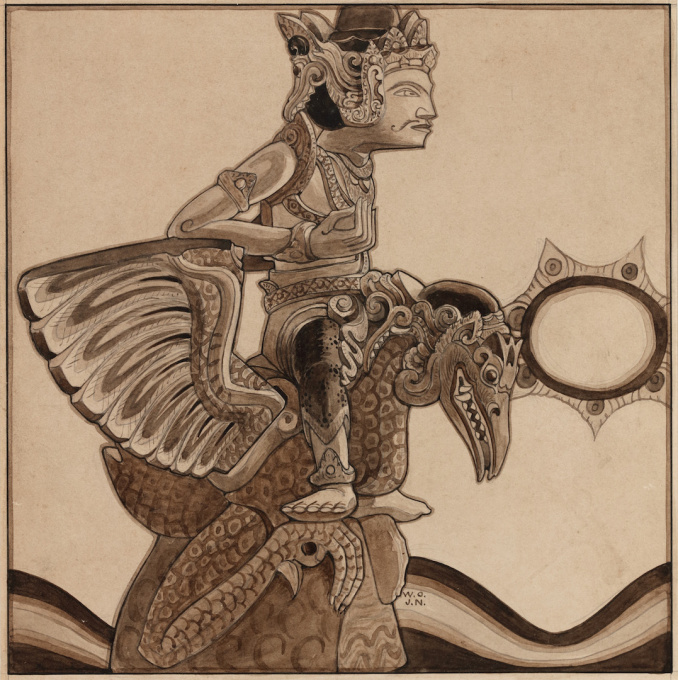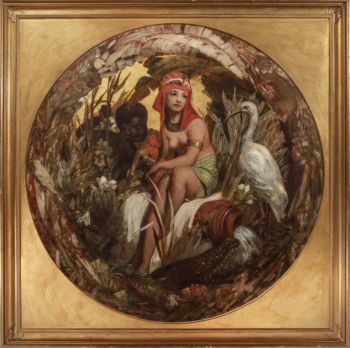Una importante colección de dibujos de W.O.J. Nieuwenkamp (1874-1950) 1900
Willem Otto Wijnand Nieuwenkamp
Precio a consultar
Zebregs & Röell - Fine Art - Antiques
- Sobre la obra de arteAn important collection of drawings by W.O.J. Nieuwenkamp (1874-1950)
From the estate of family of the artist
WILLEM OTTO WIJNAND NIEUWENKAMP (1874-1950)
Nieuwenkamp was born on July 27th 1874 in Amsterdam. His father owned sailing ships sailing to Indonesia and hearing the stories of the returning captains evoked in the young Nieuwenkamp an obsession for distant lands and adventure. After a failed attempt by his father to have his son make a career in his business, Nieuwenkamp attended the Academy for Decorative Art in Amsterdam. However, he left within one year to go his own way.
He was an autodidact and a great experimenter with new techniques, particularly in the art of etching. Nieuwenkamp was a very focused man with the discipline of a scientist tempered by the sensitivity of an artist, a lust for adventure, a natural appreciation for ethnic arts and an enormous ambition to tread new paths.
In 1898 he visited Indonesia for the first time and on his second visit in 1903-1904 he went on to Bali and became the first foreign artist to love Bali and the Balinese with a passion. Having secured agreements with several museums in the Netherlands to obtain Balinese art and objects for their collections, Nieuwenkamp immediately started to purchase and order a wide range of ethnographic art and objects from local artists and craftsmen.
Through his drawings and books, he gave an excellent impression of Balinese art and culture at that time. Since 1854 Northern Bali was under Dutch rule but Southern Bali in 1904, when Nieuwenkamp visited it, was still independent. Nieuwenkamp would be one of the last Westerners to experience a glorious medieval society in its final days. During his second visit to Bali in 1906 the Dutch decided to end the independence of South Bali and Nieuwenkamp was invited by the Governor-General van Heutz to accompany the Dutch invasion force. By contemporary European standards, the Balinese were barbarous and primitive, particularly with widows throwing themselves in the flames of the funeral pyre of their deceased husbands. But Nieuwenkamp was a singular man who saw in their society the beauty and soul that had been lost in his own.
On September 20th, 1906, Denpasar, the capital of South Bali fell to the Dutch military forces. Official military briefings praised the victory which was reported with nationalistic pride on the front pages of all Dutch newspapers. As Nieuwenkamp had witnessed, the truth was far from glorious. As if in trance the Balinese, men women and children, dressed in their finest silks and jewellery and armed with ancient bejewelled krises, the Raja himself mounted atop a golden palanquin, rushed forward, the men killing their wives and children and the Dutch machinegun fire doing the rest. The once-powerful and magnificent court of Denpasar was left in ashes and as many as two thousand Balinese dead. The Dutch suffered four deads.
Nieuwenkamp made drawings and saved as many beautiful architectural elements and artefacts from the rubbles as he could, most of it now in the collection of the Ethnological Museum in Leiden. - Sobre el artistaWILLEM OTTO WIJNAND NIEUWENKAMP Nieuwenkamp nació el 27 de julio de 1874 en Amsterdam. Su padre era dueño de veleros que navegaban hacia Indonesia y escuchar las historias de los capitanes que regresaban evocaba en el joven Nieuwenkamp una obsesión por las tierras lejanas y la aventura. Después de un intento fallido de su padre para que su hijo hiciera una carrera en su negocio, Nieuwenkamp asistió a la Academia de Arte Decorativo en Amsterdam. Sin embargo, se fue dentro de un año para seguir su propio camino. Fue un autodidacta y un gran experimentador con nuevas técnicas, particularmente en el arte del grabado. Nieuwenkamp era un hombre muy centrado con la disciplina de un científico templado por la sensibilidad de un artista, un ansia de aventura, una apreciación natural por las artes étnicas y una enorme ambición por recorrer nuevos caminos. En 1898 visitó Indonesia por primera vez y en su segunda visita en 1903-1904 fue a Bali y se convirtió en el primer artista extranjero en amar Bali y los balineses con pasión. Habiendo obtenido acuerdos con varios museos en los Países Bajos para obtener arte y objetos balineses para sus colecciones, Nieuwenkamp inmediatamente comenzó a comprar y ordenar una amplia gama de arte y objetos etnográficos de artistas y artesanos locales. A través de sus dibujos y libros, dio una excelente impresión del arte y la cultura balinesa en ese momento. Desde 1854, el norte de Bali estaba bajo el dominio holandés, pero el sur de Bali en 1904, cuando Nieuwenkamp lo visitó, todavía era independiente. Nieuwenkamp sería uno de los últimos occidentales en experimentar una gloriosa sociedad medieval en sus últimos días. Durante su segunda visita a Bali en 1906, los holandeses decidieron poner fin a la independencia del sur de Bali y Nieuwenkamp fue invitado por el gobernador general van Heutz a acompañar a la fuerza de invasión holandesa. Según los estándares europeos contemporáneos, los balineses eran bárbaros y primitivos, especialmente con las viudas que se arrojaban a las llamas de la pira funeraria de sus maridos fallecidos. Pero Nieuwenkamp era un hombre singular que vio en su sociedad la belleza y el alma que se había perdido en la suya. El 20 de septiembre de 1906, Denpasar, la capital del sur de Bali, cayó ante las fuerzas militares holandesas. Las reuniones informativas militares oficiales elogiaron la victoria, que se informó con orgullo nacionalista en las portadas de todos los periódicos holandeses. Como había presenciado Nieuwenkamp, la verdad distaba mucho de ser gloriosa. Como si estuvieran en trance los balineses, hombres, mujeres y niños, vestidos con sus mejores sedas y joyas y armados con antiguos krises enjoyados, el propio Raja subió a un palanquín dorado, corrió hacia adelante, los hombres matando a sus esposas e hijos y el fuego de la ametralladora holandesa haciendo el resto. La otrora poderosa y magnífica corte de Denpasar quedó reducida a cenizas y hasta dos mil balineses muertos. Los holandeses sufrieron cuatro muertos. Nieuwenkamp hizo dibujos y salvó tantos hermosos elementos arquitectónicos y artefactos de los escombros como pudo, la mayoría de ellos ahora en la colección del Museo Etnológico de Leiden.
¿Está interesado en comprar esta obra de arte?
Related artworks
Eduard Charlemont
‘Allegories of Africa and America’1872
Precio a consultarZebregs & Röell - Fine Art - Antiques
Artista Desconocido
A rare Japanese export lacquer medical instrument box1650 - 1700
Precio a consultarZebregs & Röell - Fine Art - Antiques
Thea G.F. Eschauzier
Retrato de una niña javanesa1931
Precio a consultarZebregs & Röell - Fine Art - Antiques
Artista Desconocido
A Kayapo Amazon Indigenous feather headdress1950 - 1960
Precio a consultarZebregs & Röell - Fine Art - Antiques
1 - 4 / 12


























